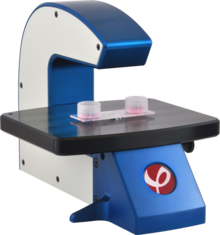Quantitative phase-contrast microscopy

A quantitative phase contrast microscope imaging cultured cells in a slide based cell culture vessel.
|
|
| Acronym | QPCM |
|---|---|
| Other names | Phase microscope, Quantitative phase microscopy |
| Uses | Microscopic observation and quantification of unstained biological material |
| Related items | Phase contrast microscopy, Differential interference contrast microscopy, Hoffman modulation contrast microscopy, Ptychography |
Quantitative phase contrast microscopy is the collective name for a group of microscopy methods that quantify the phase shift that occurs when light waves pass through a more optically dense object.
Translucent objects, like a living human cell, absorb and scatter small amounts of light. This makes translucent objects difficult to observe in ordinary light microscopes. Such objects do, however, induce a phase shift that can be observed using a phase contrast microscope. Conventional phase contrast microscopy and related methods, such as differential interference contrast microscopy, quantitative phase microscopy, or digital holographic microscopy, visualize phase shifts by transforming phase shift gradients into intensity variations. These intensity variations are mixed with other intensity variations, making it difficult to extract quantitative information.
Quantitative phase contrast methods are distinguished from other phase contrast methods in that they create a second so-called phase shift image or phase image, independent of the intensity (bright field) image. Phase unwrapping methods are generally applied to the phase shift image to give absolute phase shift values in each pixel, as exemplified by Figure 1.
The principal methods for measuring and visualizing phase shifts include ptychography,Fourier ptychography, and various types of holographic microscopy methods such as digital holographic microscopy, holographic interference microscopy and digital in-line holographic microscopy. Common to these methods is that an interference pattern (hologram) is recorded by a digital image sensor. From the recorded interference pattern, the intensity and the phase shift image is numerically created by a computer algorithm.
...
Wikipedia
